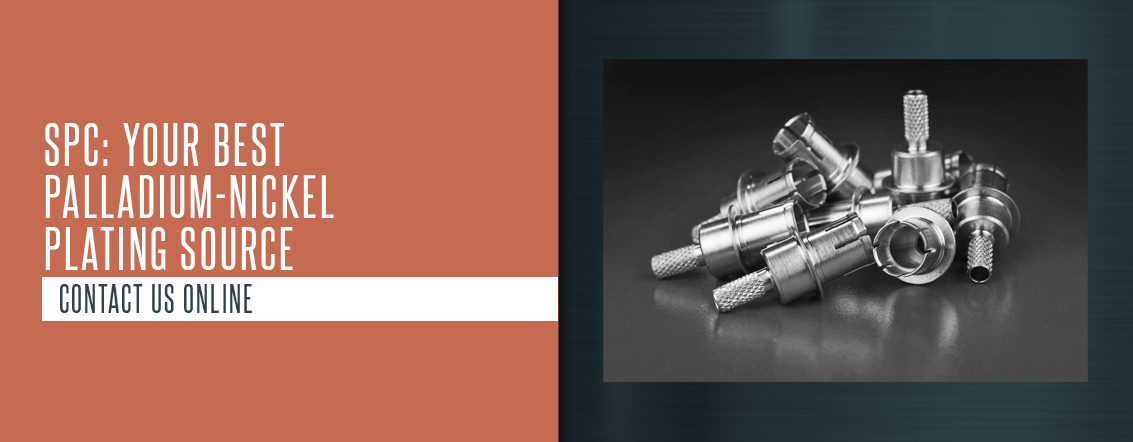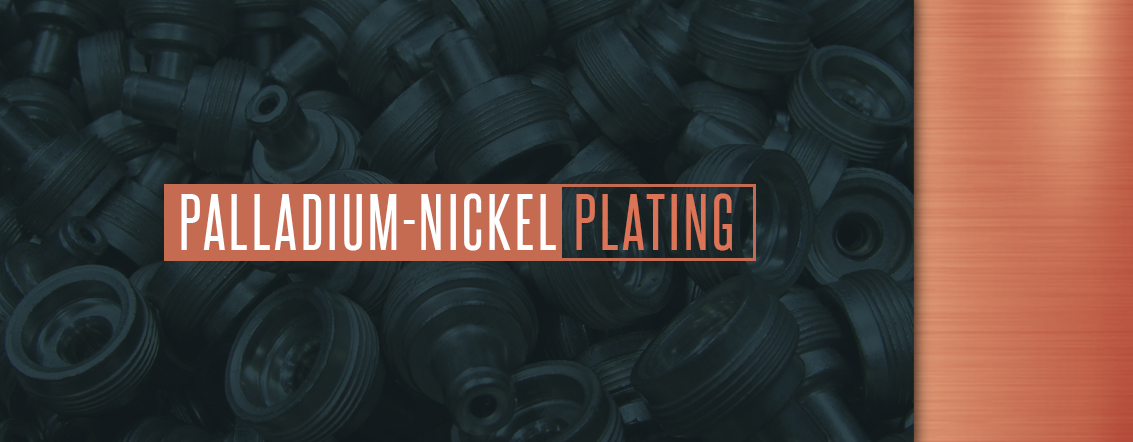
Palladium-Nickel Plating
Creating a palladium-nickel (Pd-Ni) alloy for plating brings together the benefits of both these metals for a durable, lower-cost alternative to gold and other coatings. This alloy performs better than either metal used alone in many applications. Find out the answers to your questions on this plating option to see if it will fit your project requirements.
Quick Links
Palladium-Nickel Plating Capabilities | Plating Methods
Pd-Ni Plating Specifications | Pd-Ni Plating FAQs | SPC: Your Best Palladium-Nickel Plating Source
Palladium-Nickel Plating Capabilities
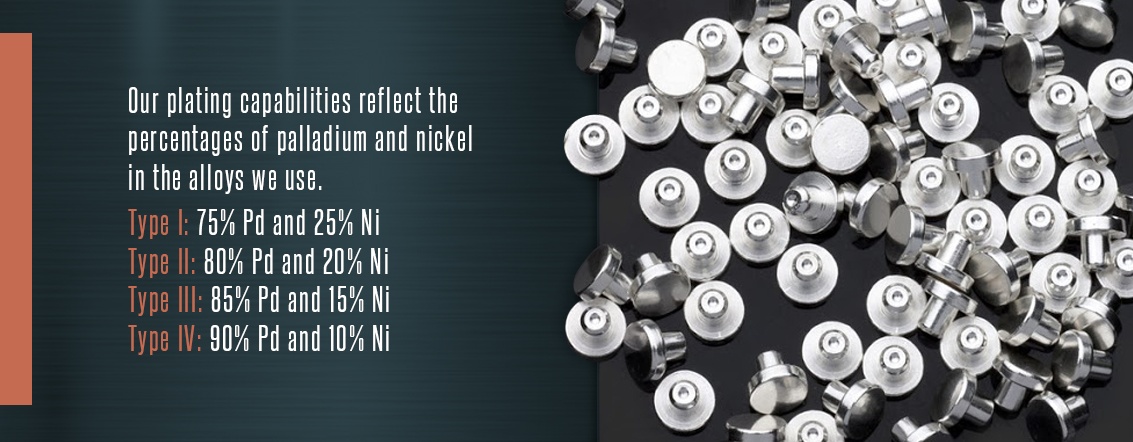
Our plating capabilities reflect the percentages of palladium and nickel in the alloys we use. We offer the following compositions in our palladium-nickel electroplating services:
- Type I: 75% Pd and 25% Ni
- Type II: 80% Pd and 20% Ni
- Type III: 85% Pd and 15% Ni
- Type IV: 90% Pd and 10% Ni
Plating Methods
Request a free quote
For Palladium Nickel Coating
Pd-Ni Plating Specifications
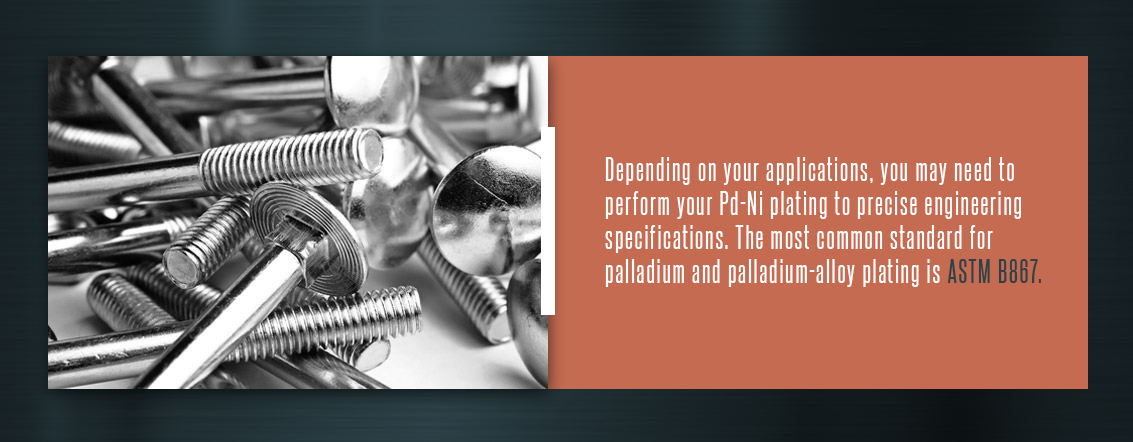
Depending on your applications, you may need to perform your Pd-Ni plating to precise engineering specifications. The most common standard for palladium and palladium-alloy plating is ASTM B867.
ASTM B867 is a specification that outlines palladium-nickel use in engineering applications. Each Pd-Ni coating must adhere to specific purity, thickness, adhesion, composition and appearance requirements. Its composition types include:
- Type I: Alloy made with 75 percent Pd and 25 percent Ni
- Type II: Alloy made with 80 percent Pd and 20 percent Ni
- Type III: Alloy made with 85 percent Pd and 15 percent Ni
- Type IV: Alloy made with 90 percent Pd and 10 percent Ni
Pd-Ni Plating FAQs
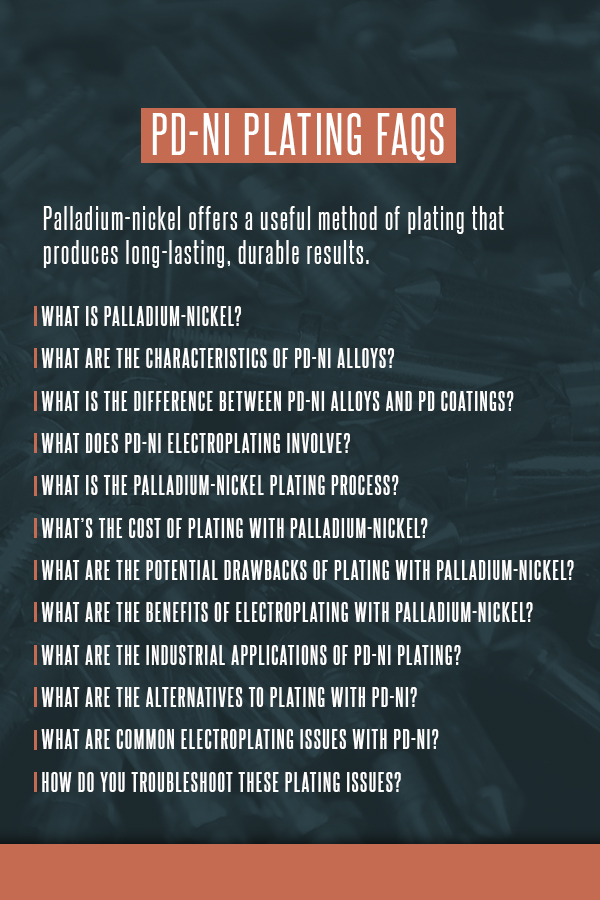
Palladium-nickel offers a useful method of plating that produces long-lasting, durable results. These questions address some of the most common concerns we see concerning our palladium-nickel plating process.
1. What Is Palladium-Nickel?
Pd-Ni is an alloy with between 70% and 95% of palladium by mass and the remaining made of nickel.5 Plating with Pd alone exists, but this method poses a risk of cracking in high-stress applications. By combining Pd with Ni, the alloy has a stronger composition, making it more acceptable for high-wear uses.
To adhere to the ASTM B867 standard, the Pd-Ni coating must have at least 70% palladium. Nickel and palladium amounts cannot exceed 5% of the masses specified by their type. For example, for this alloy to qualify as a Type III, it must have palladium and nickel within five percentage points above or below 85% and 15%, respectively.
In some cases, a palladium-nickel alloy may use a nickel underplating or a gold overplating. The former creates a barrier between a copper base and the alloy coating. The latter allows for electrical connectors to function at their best.
2. What Are the Characteristics of Pd-Ni Alloys?
Palladium-nickel alloy coatings have several characteristics that help them perform better in applications that require extra durability and lower weight without compromising corrosion resistance.
The density of this alloy measures between 10 and 11.5, which is much less than gold's density of 17.0 to 19.3. Because this alloy has a lower weight for its mass, you can get a greater thickness from the plating compared to gold without increasing the total weight.
Another aspect of a palladium-nickel alloy that makes it an excellent choice for specific electroplating applications is its durability. While palladium alone has a hardness between 75 and 600, making it slightly harder than gold, palladium-nickel alloys have a hardness that ranges from 300 to 650, depending on the composition.
Palladium-nickel coatings must perform under extreme heat stress to adhere to the ASTM B867 standard. To verify this, you must put the coated material through tests that examine its performance when exposed to temperatures between 300 and 350 degrees Celsius (570 to 660 degrees Fahrenheit) for at least 30 minutes.13 The metal coating cannot show any flaking, peeling or blistering after this test.
Proven performance at such high temperatures for extended times shows the ability of Pd-Ni coating to withstand damage from high heat applications.
3. What Is the Difference Between Pd-Ni Alloys and Pd Coatings?
While they both have palladium, Pd and the alloy that mixes it with nickel have distinct properties that make the Pd-Ni alloy better for some applications.
When used as a plating material on its own, palladium offers a more durable, cheaper alternative to gold. However, this metal does not possess high corrosion resistance or durability. For high-stress applications, you will need to choose a palladium-nickel alloy. The addition of nickel increases the hardness of the coating while increasing its resistance to a variety of stresses. Corrosion-resistant and capable of withstanding higher temperatures than palladium, a Pd-Ni alloy coating performs better in applications that require higher levels of durability.
4. What Does Pd-Ni Electroplating Involve?
Pd-Ni plating uses the electroplating process to administer a thin layer of a palladium-nickel alloy over another type of metal surface. Experts start the electroplating process by dissolving the ions of the palladium-nickel alloy — along with other specially selected compounds — into a liquid electrolyte solution. They then place the object to be plated into the solution and run an electric current, which makes the ions bond to the product's surface. The result is a palladium-nickel coating that covers and protects the entire surface.
If you need plating in only specific areas of your product, you can also use selective palladium plating. Using a specialized brush and an electrolyte plating solution, operators can perform selective plating of electrical contacts or other targeted areas. This method is ideal for low-volume requirements.
5. What Is the Palladium-Nickel Plating Process?
To achieve the finished plated product, we use barrel or rack plating for many of our palladium-nickel coatings. The type of process you choose will contribute to the total cost and the finish of the products.
Barrel plating works best with small, durable parts that can withstand tumbling in a barrel of electroplating liquid. Compared to rack plating, barrel plating costs less. Not all projects can use barrel plating. Parts with intricate shapes or those too large for the barrels will need to undergo rack plating.
Rack plating requires a worker to affix each piece into a rack to hold it still during the process. This extra effort increases the cost, but for parts that you cannot barrel plate, rack plating serves as a good alternative.
Once in the electroplating bath, the plating proceeds in the same manner with an electric current laying down ions of the alloy onto the parts' surfaces.
6. What’s the Cost of Plating With Palladium-Nickel?
The cost of plating with a Pd-Ni alloy depends on several factors. The type of alloy used, the thickness needed and the plating method all contribute to the overall cost.
Compared to gold plating, though, Pd-Ni alloy costs less and offers a higher hardness for added durability. While Pd plating provides a lower-cost alternative to gold, mixing nickel and palladium into an alloy reduces the price even more.
7. What Are the Potential Drawbacks of Plating With Palladium-Nickel?
While a Pd-Ni alloy offers numerous benefits, it poses some problems in specific applications. In many cases, though, with proper troubleshooting, you can solve these issues.
First, Pd-Ni coating does not perform well when used in mated parts that move against each other. The plating has a higher coefficient of friction compared to other metals, resulting in fretting wear. If you have pieces that move against each other, at least one of them should not have a Pd-Ni coating on the surface.
Pd-Ni does not solder as well as other metals. If you need points for soldering, consider adding a gold overplating to those sites on the surface. You may have to use this technique of using a gold overplating to improve conduction at electronic contacts, as well. Opting to choose gold for some areas lets you take advantage of gold's benefits on those parts without incurring the cost of coating the entire surface with gold.
8. What Are the Benefits of Electroplating With Palladium-Nickel?
The combination of palladium and nickel provides exceptional benefits in numerous applications. Each has unique advantages that, when combined, make the alloy one of the best choices for electronics applications:
- Palladium: Palladium is lightweight but still as corrosion-resistant as gold. It also resists oxidation and maintains a uniform color that won't typically need to be re-plated.
- Nickel: Nickel is another corrosion-resistant metal that offers exceptional element resistance. Nickel plating is also known for its friction reduction in several materials.
Because a palladium-nickel alloy is harder than gold, it is also less sensitive to fluctuations during the plating process. Its high density also makes it able to withstand extreme heat. Additionally, palladium-nickel plating can be an ideal choice for any project when there is a need to create a barrier between base metals such as nickel, copper or gold.
In addition to high density, palladium-nickel alloy plating provides a lightweight coating that resists corrosion and cracking in ways that either individual metal could not do. For example, palladium may crack under stress, but mixing it with nickel reduces the likelihood of cracks forming.
9. What Are the Industrial Applications of Pd-Ni Plating?
Palladium-nickel plating works well in applications that require exposure to extreme heat. Additionally, in any parts that need a barrier between base metals such as nickel, gold or copper, Pd-Ni plating provides the required separation.
More specifically, the electronics, automotive and biomedical industries use this coating. Pd-Ni coating with a layer of gold on top is an excellent conductive surface for electronics contacts in applications for these and other sectors.
10. What Are the Alternatives to Plating With Pd-Ni?
Palladium-nickel coating typically serves as an alternative to gold plating alone. This option allows for good solderability and conductivity, but it often costs more due to the use of a precious metal. You can achieve similar results with a Pd-Ni coating and a thin gold overplating.
11. What Are Common Electroplating Issues With Pd-Ni?
In some instances, the Pd-Ni plating process may require some changes to prevent common issues. These problems include pore corrosion due to moisture leaching through pores in the surface coating to the base metal.
If you have an uneven base, the electroplating may not cover the surface evenly across the entire part. Additionally, copper used as a base can move into the Pd-Ni coating, causing damage to the plating. Using a nickel underplating may help to solve some of these problems.
Other issues include a lack of desirable performance in solderability and conducting electricity. Both problems have the same solution — an overplating of gold.
12. How Do You Troubleshoot These Plating Issues?
For pore corrosion in humid environments, you may choose to add an underplating of nickel.11 This layer of Ni coating under the Pd-Ni layer also prevents problems caused by uneven base materials or from copper in the base diffusing into the coating.
If you have a Pd-Ni coated part that you have trouble soldering, adding an overplating of gold can help. This solution may also help for electrical connectors that require high performance in conductivity. 12
Check the surfaces at the points where moving parts touch each other, such as a track where bearings roll. Excessive wear at this location could occur from fretting. Fretting corrosion is a similar type of damage caused by oxide formation at the site. Pd-Ni coatings that exhibit fretting could need an overplating of gold to reduce the wear. Gold's lower coefficient of friction helps parts to move more smoothly against each other while minimizing wear. When using gold to mitigate problems of friction between components, you may use either Type 1 or Type 2 gold. If you choose Type 1 gold coating, it should measure between 0.05 and 0.12 micrometers. Type 2 gold can have a greater thickness between 0.05 and 0.25 micrometers. If you need thicker areas of gold, select Type 2 gold coating.12
If you have an application in which two coating parts move against each other, do not have both coated in Pd-Ni to avoid frictional wear. Coating one of the surfaces with gold can reduce this form of wear.
SPC: Your Best Palladium-Nickel Plating Source
With more than 80 years of experience in the plating industry, SPC is a widely recognized industrial plating leader. Our team of engineers, scientists and production personnel is committed to one goal: achieving total customer satisfaction.
As well as palladium-nickel plating, we offer a wide variety of alternatives to satisfy your every plating need. Our expertise spans industries like biomedical, automotive, electronics and more, and we understand how to pick exactly the right material that meets your industry-specific requirements. Plating consulting services are also available to help you select and implement the ideal plating process for your company. Contact us online to learn more about palladium-nickel plating today!
LEARN WHAT OUR MANY SATISFIED CUSTOMERS HAVE TO SAY ABOUT Us
"I would like to thank you for the help you have provided us in developing an electroless nickel plating technique on an unusual substrate. The sample platings you provided show that we should be able to reach our goals. I especially appreciate your willingness to take on an unusual job, with the uncertainties that that entails...We are looking forward to working with you in the future on our plating needs."
– Robert K.


